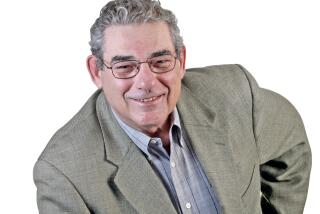Former Reporter Made Up Stories, USA Today Finds
- Share via
WASHINGTON — USA Today, one of the nation’s largest-circulation newspapers, said Friday it had found that a former star foreign correspondent had made up parts of at least eight stories, committing “journalistic sins” that were “sweeping and substantial.”
In a front-page article, the Gannett Co. newspaper said that a team of reporters and an editor found evidence of repeated fabrications during an examination of 720 articles written by Jack Kelley between 1993 and 2003.
It said the evidence “strongly contradicted” Kelley’s stories that he had spent a night with Egyptian terrorists; met a vigilante Jewish settler; taken part in a dangerous hunt for Osama bin Laden; visited a terrorist gathering point on the Afghan-Pakistan border; and watched a Pakistani student “unfold a picture of the Sears Tower and say, ‘This one is mine.’ ”
The newspaper said Kelley’s “most egregious misdeed” took place in 2000, when he used a photo he took of a Cuban hotel worker as the basis for a phony story about a woman who died fleeing the country by boat.
In fact, the woman did not flee, was alive and was found by a reporter earlier this month, the paper said.
Kelley, 43, was a 21-year veteran whose editors had nominated him five times for the Pulitzer Prize, and was a personal favorite of USA Today founder Al Neuharth. But three well-known former editors who oversaw the research into his work said his conduct represented a “sad and shameful betrayal of the public trust.” The newspaper quoted its publisher, Craig Moon, saying: “As an institution, we failed our readers by not recognizing Jack Kelley’s problems. For that I apologize.”
The paper said Kelley, who resigned earlier this year after admitting to editors that he misled them, continued to insist that he did nothing wrong. It said that he told the staff members on Thursday, “I feel like I’m being set up.” His attorney, Lynne Bernabei of Washington, said in an interview Friday that Kelley had no comment on the paper’s findings.
The newspaper’s findings mark the latest in a series of scandals over fabrications and plagiarism in the news industry.
Last May, the New York Times reported after a lengthy investigation that reporter Jayson Blair had fabricated or plagiarized parts of at least three dozen articles.
The paper’s two top editors left the paper in the self-examination that followed.
USA Today began its investigation of Kelley earlier this year after a staff member raised questions about a story.
One of Kelley’s most vivid stories that was discredited in the probe involved a suicide bombing at a Jerusalem pizzeria that he claimed to have witnessed in 2001.
He wrote in the story that “three men, who had been eating pizza inside, were catapulted out of their chairs.... When they hit the ground, their heads separated from their bodies and rolled down the street.” In his first draft that he turned in, Kelley wrote that some of the heads rolled “with their eyes still blinking.”
But the paper said it was unclear how Kelley could have witnessed this, since he said he was 90 feet away, with his back to the pizzeria, when the bombing took place. It quoted officials saying that no one was decapitated in the bombing.
Another story, written from Pakistan in 2002, claimed to offer a firsthand look at how suspected Al Qaeda terrorists eluded U.S. commandos in the mountains of the North Waziristan region. But the investigation concluded that Kelley could not have reached the tiny hamlet where he claimed that action took place. They reported that some of the descriptions and quotations were similar to those found in stories from other publications.
The paper said Kelley tried to undermine the investigation by providing scripts to potential alibi witnesses suggesting how they might corroborate his version of events.
The examination into Kelley’s work was overseen by John Siegenthaler, founding editorial director of USA Today; Bill Kovach, chairman of the Committee of Concerned Journalists; and Bill Hilliard, former editor of the Oregonian in Portland.
In an interview, Siegenthaler said the examination indicated that some people outside the paper were involved in helping Kelley cover up the fabrications. Inside the paper, no one was implicated, he said, though Kelley clearly had a number of “supporters and admirers.”
In the next phase of their work, the outside editors will try to draw conclusions about whether the newspaper needs to change procedures to make sure there is no repeat of what Kelley did. They have reached no preliminary conclusion on that question, however, Kovach said.
At the newspaper, the staff was shaken by the breadth of the deceptions revealed in the investigation. In addition to a front-page story, two inside pages were spent explaining the problems uncovered.
“It’s a rough day for the paper,” Peter Johnson, a media columnist who has worked at USA Today since 1983, told Associated Press. “The shock is settling in here, and people are just trying to digest an unsettling report.”
U.S. intelligence officials have long been critical of Kelley’s work. One official said he had complained to the paper on numerous occasions, dating back to 2000. Kelley frequently wrote about purported intelligence operations and the activities of clandestine military units.
Surveys by the Pew Research Center for the People and the Press have found steadily declining trust in newspapers over the past 15 years. The share of people who believe what they read in their daily newspaper fell from 80% in 1985 to 59% in 2003, according to the surveys.
Alex Jones, director of the Shorenstein Center on the Press, Politics and Public Policy at the John F. Kennedy School of Government at Harvard University, praised USA Today “for the upfront way they dealt with all of this.” He said the short-term effect for the news industry will be negative.
“People will be disgusted and at least for a time will conclude that there are more crooks out there than they imagined. But I think that will pass, because the news organizations are stepping up to acknowledge their responsibility.”
Another lesson of the episode, Jones said, is that the existence of Internet and news databases mean that more people can now review news stories to identify mistakes and fabrications. “The world is getting smaller for crooks and liars; it’s getting easier to spot them now,” Jones said.
Staff writer Greg Miller contributed to this reporter.
More to Read
Sign up for Essential California
The most important California stories and recommendations in your inbox every morning.
You may occasionally receive promotional content from the Los Angeles Times.











